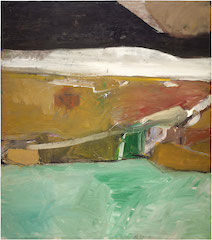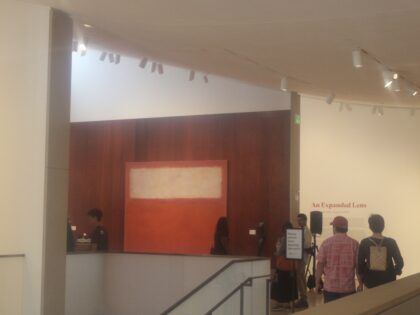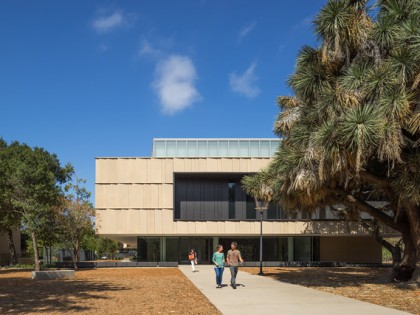Beyond famous U.S. art museums, those at public and private universities are often overlooked. The following eight across the nation have collections and exhibits that are not only worth seeing but also housed in strikingly modern buildings, like the Broad, designed by Zaha Hadid, in Michigan. Most are open year round (even in summer) and free to visit. All offer special exhibits this fall, too.
1. Weisman Art Museum, University of Minnesota
How to visit: Free. Open 10 a.m.–5 p.m., Wednesday–Friday; 11 a.m.–5 p.m., Saturday & Sunday.
One look and you know who designed this curvy, shiny building: Frank Gehry. It opened in 1993, and Gehry also handled its expansion in 2011, which almost doubled gallery space. The collection is especially strong in American art, including ceramics, and Korean furniture and decorative objects. Two special fall exhibits focus on Black Americans and contemporary Black artists. Kara Walker: Harper’s Pictorial History of the Civil War (Annotated) will include 15 large-scale prints (September 28 through December 29), while Seeking for the Lost presents portraits painted by Christopher Harrison, imagining what formerly enslaved people “lost” after the Civil War looked like (now through February 16, 2025).
2. Sidney and Losi Eskenazi Museum of Art, Indiana University
How to visit: Free. Open noon–5 p.m. daily, except Monday. Café and gift shop opens at 8 a.m. weekdays.
Opened in 1982, this modernist building was designed by I.M. Pei, with a focus on geometry, as in his other art museum work. The collection, which includes some 45,000 items, started earlier and is now one of the largest in a U.S. university art museum. Seven galleries include collections of African art, Indigenous art of the Americas, photography, contemporary art, and more. From September 5 to December 15, paintings by Indiana-born rock star John Mellencamp are surveyed in the Crossroads exhibit. Thanks to a major donation by the Eskenazis, the museum was fully renovated in 2016.
Pointed silver building with slots
The Eli and Edythe Broad Art Museum was designed by architect Zaha Hadid.
Photo by EQRoy/Shutterstock
3. Eli and Edythe Broad Art Museum, Michigan State University
How to visit: Free. Open 10 a.m.–6 p.m. Wednesday–Sunday.
It’s a bold building, designed by Zaha Hadid—one of only four U.S. buildings by the acclaimed Iraqi British architect (and the first woman to win the Pritzker Prize). As its angular steel exterior suggests, the focus here is on contemporary art. Recent acquisitions span various media: video, inkjet prints on aluminum, vintage gelatin silver prints, plus a range of works by Hadid herself, including silver jewelry and larger designs in marble and Cristalflex and Lentiflex. A newly commissioned installation, Complex Dreams, by Esmaa Mohamoud, is on exhibit from mid-September through mid-February. (The Broads are also the philanthropists behind Los Angeles’s Broad museum, which is not affiliated with a university.)
4. Michael C. Carlos Museum, Emory University
How to visit: $8 for adults; $6 for seniors and children age 6–17. Open 10 a.m.–5 p.m. Tuesday–Saturday; noon–5 p.m. Sunday.
Emory’s collection began in 1876; the current museum is a 1993 renovation and expansion of the old law school building, with a distinctive postmodern façade by architect Michael Graves. This museum boasts the Southeast’s biggest collection of ancient art, from Egypt to the ancient Americas, while another gallery is devoted to works of art on paper, which includes modern works. This fall brings two special exhibits: Picture Words: Greek, Maya, and Moche Pottery (September 14 to December 15, 2024) and La Vaughan Belle: Come Ruin or Rapture (September 19 to December 8, 2024).
People sitting and walking around a foyer with blue walls, benches, and arched loggia
You can’t miss the colorful foyer of the Blanton Museum of Art.
Photo by Faina Gurevich/Shutterstock
5. Blanton Museum of Art, University of Texas at Austin
How to visit: $15 adults, $12 seniors, $8 youth. Open 10 a.m.–5 p.m. Tuesday–Friday and Sunday; 10 a.m.–8 p.m. Saturday.
Like most things in Texas, this is a big museum with a big collection, focusing on contemporary American and Latin American art and Italian Renaissance and baroque paintings. Opened in 1963, the museum has evolved to include the recent additions of Snøhetta-designed shades outdoors and the unique artwork/freestanding building by minimalist artist Ellsworth Kelly, which opened in 2015.
Kelly’s only building is a gem, with colored glass windows and black and white marble panels. It offers a refuge for quiet contemplation. From now through January 12, see the Long Live Surrealism! 1924–Today exhibit.
6. Nasher Museum of Art, Duke University
How to visit: Free. Open 10 a.m.–5 p.m. Tuesday, Wednesday, Friday, and Saturday; 12 a.m.–5 p.m. Sunday; 10 a.m.–9 p.m. Thursday
Designed by Rafael Viñoly, who also handled the renovation/expansion of the Cleveland Museum of Art, the Nasher opened in 2005. In this blocky modern building, the emphasis is on contemporary art, particularly by historically underrepresented artists.
The Collection Galleries display art from the USA, Andes, Africa, and medieval Europe. A new exhibit, Second Nature: Photography in the Age of the Anthropocene, from September through January 5, 2025, is part of Duke’s 2024 Centennial Celebration. Exploring how humans have altered the global environment, it has work by 45 artists from around the world.
7. Mary and Leigh Block Museum of Art, Northwestern University
How to visit: Free. Open 12–8 p.m. Wednesday–Friday; 12–5 p.m. weekends; closed in summer.
Even art fans can only absorb so much at one time before “museum fatigue” sets in. That’s not an issue at this small, glass-clad museum of three galleries. Dirk Lohan, who studied architecture with Ludwig Mies van der Rohe (his grandfather), designed the building, which opened in 1980.
The collection’s highlights include documentary photos of the Midwest (1930s–1970s), Chicago-based printmakers (1930s–1940s), and South African township prints (1980–1990s). The Block also has a 148-seat auditorium screening free movies. Check out two special exhibits this autumn: an immersive, multiscreen video, The Great Farce, an animated satire, by Federico Solmi and Dissident Sister: Bev Grant and Feminist Activism, 1968–72, photographs of social justice movements in New York City. Both are on view through November 30.
People walking around a museum surrounded by artwork
The Anderson Collection opened in 2014.
Photo by Andrew Brodhead
8. Anderson Collection, Stanford University
How to visit: Free. Open Wednesday–Sunday, 11 a.m.–5 p.m.
This small but spacious museum is currently celebrating its 10th anniversary as a showcase for modern and contemporary American art. Richard Olcott designed the two-story building; the high-ceilinged top floor, where most of the art is displayed, is reached via a wide central stairway. The whole interior is airy: The entire second floor is open plan. Next door is the older, neo-classical Cantor Arts Center, with a larger collection (also free to visit).
Art from the Anderson’s permanent collection on display usually numbers between 90 to 100 works, making it easy to see “everything,” including paintings by such Bay Area artists as Nathan Oliveira and Richard Diebenkorn. The Expanded Lens exhibit (now through August 17, 2025) augments paintings and sculptures in the collection.
Pat Tompkins has written for Afar about movies, books, art, UNESCO World Heritage sites, and other topics.







